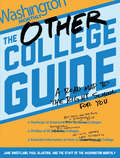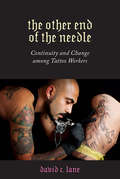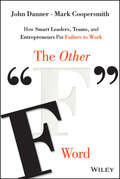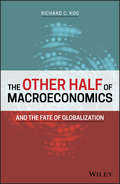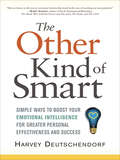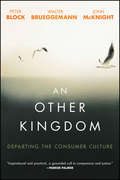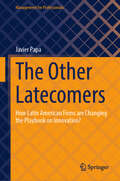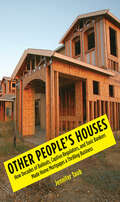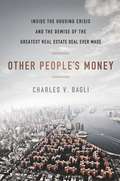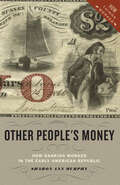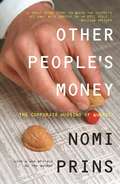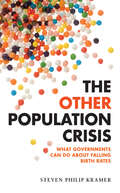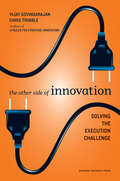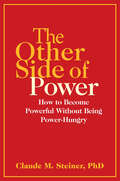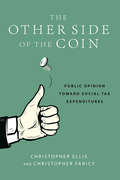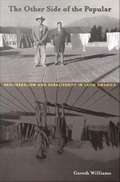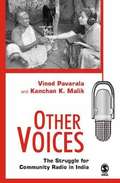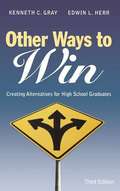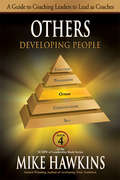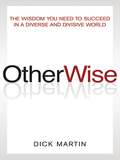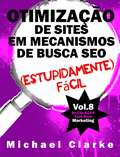- Table View
- List View
The Other College Guide
by Jane Sweetland Paul Glastris Staff Washington MonthlyA college degree has never been more important-or more expensive. If you're not made of money, where can you get an amazing liberal arts education without your parents having to remortgage the house or cash in their retirement fund? Which degrees will allow you to fulfill your dreams and earn a decent paycheck? What do you really need to know if you're the first in your family to go to college? How do you find good schools that offer a well-rounded campus life for black or Latino students?From the staff of Washington Monthly comes a new kind of college guide, inspired by and including the magazine's signature alternative college rankings. The Other College Guide features smartly designed, engaging chapters on finding the best-fit schools and the real deal about money, loans, and preparing for the world of work. This essential higher ed handbook also highlights information on what to look for (and watch out for) in online programs and for-profit colleges and concludes with fifty profiles of remarkable but frequently overlooked schools. All things being unequal, The Other College Guide will provide American students-and their families and school counselors-with the honest and practical information they need to make sense of the college process and carve a path to the future they imagine.
The Other End of the Needle: Continuity and Change among Tattoo Workers (Inequality at Work: Perspectives on Race, Gender, Class, and Labor)
by David C. LaneThe Other End of the Needle demonstrates that tattooing is more complex than simply the tattoos that people wear. Using qualitative data and an accessible writing style, sociologist Dave Lane explains the complexity of tattoo work as a type of social activity. His central argument is that tattooing is a social world, where people must be socialized, manage a system of stratification, create spaces conducive for labor, develop sets of beliefs and values, struggle to retain control over their tools, and contend with changes that in turn affect their labor. Earlier research has examined tattoos and their meanings. Yet, Lane notes, prior research has focused almost exclusively on the tattoos—the outcome of an intricate social process—and have ignored the significance of tattoo workers themselves. "Tattooists," as Lane dubs them, make decisions, but they work within a social world that constrains and shapes the outcome of their labor—the tattoo. The goal of this book is to help readers understand the world of tattoo work as an intricate and nuanced form of work. Lane ultimately asks new questions about the social processes occurring prior to the tattoo’s existence.
The Other "F" Word
by Mark Coopersmith John DannerLeverage the power of failure in your organization Nobody wants to fail, but failure is a fact of life. Most of us treat it as a regrettable, even shameful, event best overlooked. In truth, failure can be a game-changing strategic resource that can help you and your organization achieve the greater success you crave. The Other "F" Word shows how successful leaders and teams are putting failure to work every day - to re-engage employees, spark innovation and accelerate growth. Authors Danner and Coopersmith - with their rare blend of senior-level executive experience, global advising, teaching acumen and cross-discipline perspective - share these valuable new practices, and show how they can improve results across your organization. Based on exclusive interviews with prominent leaders and insightful examples from their own in-depth work, the book features a practical seven-stage framework to liberate failure as a force to advance your leadership agenda. After all, everyone creates and confronts failure on a daily basis. Why not use it to your advantage? The Other "F" Word shows you how to: Start an open, productive conversation about failure across your organization Reduce the fear of failure that stifles initiative, creativity and engagement Anticipate, prepare for and respond to failure, so you can leverage it when it happens Harness failure as a catalyst to drive innovation, improve performance and strengthen culture Failure's like gravity - pervasive and powerful. Whether you're a leader or team member of a startup, a growing business, or an established enterprise, failure is today's lesson for tomorrow. Let The Other "F" Word show you how to apply this lesson and take your company where it needs to go.
The Other Half of Macroeconomics and the Fate of Globalization
by Richard C. KooGet a new perspective from the ‘other half’ of macroeconomics The failure of the vast majority of economists in government, academia and the private sector to predict either the post-2008 Great Recession or the degree of its severity has raised serious credibility issues for the profession. The repeated failures of central banks and other policymakers in all advanced countries to meet their inflation or growth targets in spite of astronomical monetary easing, have left the public rightfully suspicious of the establishment and its economists. The Other Half of Macroeconomics and the Fate of Globalization elucidates what was missing in economics all along and what changes are needed to make the profession relevant to the economic challenges of today. Once the other half of macroeconomics is understood both as a post-bubble phenomenon and as a phase of post-industrial economies, it should be possible for policy makers to devise appropriate measures to overcome difficulties advanced countries are facing today such as stagnation and income inequality. • Shows how it’s possible to devise appropriate policy response to slow wage and productivity growth in these economies • Demonstrates that the effectiveness of monetary and fiscal policy changes as an economy undergoes different stages of development • Argues that tax rules, regulations and even educational system must be revised to match the need of pursued (by emerging nations) countries • Explains the 200-year process of economic development and where that process is taking all of us Inside, Richard C. Koo offers a completely new way of looking at the economic predicament of advanced countries today.
The Other Kind of Smart: Simple Ways to Boost Your Emotional Intelligence for Greater Personal Effectiveness and Success
by Harvey DeutschendorfEmotional intelligence (EI) coach Harvey Deutschendorf combines his proven techniques with engaging principles of storytelling and fun exercises to show you how you can apply the principles of EI on the job to achieve greater success.Filled with real-life profiles of people who faced emotional intelligence dilemmas and easy-to-implement solutions, Other Kind of Smart offers tools that will bring results in as little as five minutes a day and teaches you how to:develop stress tolerance, cultivate empathy, increase flexibility with coworkers, boost assertiveness, and resolve problems successfully.The difference between those who become successful in life and those who struggle is their ability to exhibit and leverage strong people skills. Complete with an EI quiz that will help you measure their level of emotional intelligence and EI growth, Other Kind of Smart enables all professionals to improve their relationships and increase their effectiveness at work in a practical, accessible way.
An Other Kingdom
by Walter Brueggemann John Mcknight Peter BlockOur seduction into beliefs in competition, scarcity, and acquisition are producing too many casualties. We need to depart a kingdom that creates isolation, polarized debate, an exhausted planet, and violence that comes with the will to empire. The abbreviation of this empire is called a consumer culture. We think the free market ideology that surrounds us is true and inevitable and represents progress. We are called to better adapt, be more agile, more lean, more schooled, more, more, more. Give it up. There is no such thing as customer satisfaction. We need a new narrative, a shift in our thinking and speaking. An Other Kingdom takes us out of a culture of addictive consumption into a place where life is ours to create together. This satisfying way depends upon a neighborly covenant--an agreement that we together, will better raise our children, be healthy, be connected, be safe, and provide a livelihood. The neighborly covenant has a different language than market-hype. It speaks instead in a sacred tongue. Authors Peter Block, Walter Brueggemann, and John McKnight invite you on a journey of departure from our consumer market culture, with its constellations of empire and control. Discover an alternative set of beliefs that have the capacity to evoke a culture where poverty, violence, and shrinking well-being are not inevitable--a culture in which the social order produces enough for all. They ask you to consider this other kingdom. To participate in this modern exodus towards a modern community. To awaken its beginnings are all around us. An Other Kingdom outlines this journey to construct a future outside the systems world of solutions.
The Other Latecomers: How Latin American Firms are Changing the Playbook on Innovation? (Management for Professionals)
by Javier PapaIn recent years, developing countries have seen the emergence of successful and innovative firms, albeit often with state support. Argentina, which faces challenges including industrial decline and macroeconomic turbulence, offers an intriguing context for studying latecomer firms, as few have managed to innovate and compete globally without significant state backing. This book examines why and how latecomer firms facing adverse policies and hostile macroeconomic conditions can nevertheless survive, grow, and catch up with global competitors, while many other firms lag or fall further behind. It presents, on one hand, a theoretical framework that builds on contributions made by Gerschenkron (1962) and Hobday (1995) on latecomer catch-up in economic development theory, and on those by Nelson (1991, 2008) on firm-level differences in evolutionary theory; on the other, it provides a contextual framework for the catching-up experiences of firms from East Asia and Latin America, which ends with a description of Argentina’s main detrimental policy regimes over the past 50 years. Further, the book presents an statistical analysis of manufacturing firms’ performance, along with the corporate characteristics that underlie it, within the context of Argentina’s worst economic crisis to determine which firm characteristics stood out during times of crisis (e.g. innovation and organizational capabilities). To supplement the quantitative analysis and offer additional insights, it introduces two in-depth case studies on iconic latecomer firms, TENARIS and IMPSA, which, bolstered by the examination of over nearly half a million newspaper articles, illustrate their global success amidst numerous challenges. It emphasizes the importance of long-term corporate strategy, a flexible organizational structure, and a coherent set of technological and organizational capabilities, while also addressing policy implications, making it a valuable asset for researchers, policymakers, and corporate managers alike.
Other People's Houses: How Decades of Bailouts, Captive Regulators, and Toxic Bankers Made Home Mortgages a Thrilling Business
by Jennifer TaubThe clearest explanation yet of how the financial crisis of 2008 developed and why it could happen againIn the wake of the financial meltdown in 2008, many claimed that it had been inevitable, that no one saw it coming, and that subprime borrowers were to blame. This accessible, thoroughly researched book is Jennifer Taub&’s response to such unfounded claims. Drawing on wide-ranging experience as a corporate lawyer, investment firm counsel, and scholar of business law and financial market regulation, Taub chronicles how government officials helped bankers inflate the toxic-mortgage-backed housing bubble, then after the bubble burst ignored the plight of millions of homeowners suddenly facing foreclosure.Focusing new light on the similarities between the savings and loan debacle of the 1980s and the financial crisis in 2008, Taub reveals that in both cases the same reckless banks, operating under different names, received government bailouts, while the same lax regulators overlooked fraud and abuse. Furthermore, in 2013 the situation is essentially unchanged. The author asserts that the 2008 crisis was not just similar to the S&L scandal, it was a severe relapse of the same underlying disease. And despite modest regulatory reforms, the disease remains uncured: top banks remain too big to manage, too big to regulate, and too big to fail.
Other People's Money
by Charles V. BagliIn just over three years, real estate giant Tishman Speyer and its partner, BlackRock, lost billions of investors' dollars on a single deal. The New York Times reporter who first broke the story of the sale of Stuyvesant Town-Peter Cooper Village takes readers inside the most spectacular failure in real estate history, using this single deal as a lens to see how and why the real estate crisis happened. How did the smartest people in real estate lose billions in one single deal? How did the Church of England, the California public employees' pension fund, and the Singapore government lose more than one billion dollars combined investing in a middle-class housing complex in New York City? How did MetLife make three billion dollars on the deal without any repercussions from a historically racist policy of housing segregation? And how did nine residents of a sleepy enclave in New York City win one of the most unlikely lawsuits in the history of real estate law? Not only does Other People's Money answer those questions, it also explains the current recession in stark, clear detail while providing riveting first-person accounts of the titanic failure of the real estate industry to see that a recession was coming. It's the definitive book on real estate during the bubble years--and what happened when that enormous bubble exploded.
Other People's Money: The Real Business of Finance
by John KayThe finance sector of Western economies is too large and attracts too many of the smartest college graduates. Financialization over the past three decades has created a structure that lacks resilience and supports absurd volumes of trading. The finance sector devotes too little attention to the search for new investment opportunities and the stewardship of existing ones, and far too much to secondary-market dealing in existing assets. Regulation has contributed more to the problems than the solutions. Why? What is finance for? John Kay, with wide practical and academic experience in the world of finance, understands the operation of the financial sector better than most. He believes in good banks and effective asset managers, but good banks and effective asset managers are not what he sees. In a dazzling and revelatory tour of the financial world as it has emerged from the wreckage of the 2008 crisis, Kay does not flinch in his criticism: we do need some of the things that Citigroup and Goldman Sachs do, but we do not need Citigroup and Goldman to do them. And many of the things done by Citigroup and Goldman do not need to be done at all. The finance sector needs to be reminded of its primary purpose: to manage other people’s money for the benefit of businesses and households. It is an aberration when the some of the finest mathematical and scientific minds are tasked with devising algorithms for the sole purpose of exploiting the weakness of other algorithms for computerized trading in securities. To travel further down that road leads to ruin.
Other People's Money: How Banking Worked in the Early American Republic (How Things Worked)
by Sharon Ann MurphyHow the contentious world of nineteenth-century banking shaped the United States.Pieces of paper that claimed to be good for two dollars upon redemption at a distant bank. Foreign coins that fluctuated in value from town to town. Stock certificates issued by turnpike or canal companies—worth something... or perhaps nothing. IOUs from farmers or tradesmen, passed around by people who could not know the person who first issued them. Money and banking in antebellum America offered a glaring example of free-market capitalism run amok—unregulated, exuberant, and heading pell-mell toward the next "panic" of burst bubbles and hard times. In Other People’s Money, Sharon Ann Murphy explains how banking and money worked before the federal government, spurred by the chaos of the Civil War, created the national system of US paper currency. Murphy traces the evolution of banking in America from the founding of the nation, when politicians debated the constitutionality of chartering a national bank, to Andrew Jackson’s role in the Bank War of the early 1830s, to the problems of financing a large-scale war. She reveals how, ultimately, the monetary and banking structures that emerged from the Civil War also provided the basis for our modern financial system, from its formation under the Federal Reserve in 1913 to the present. Touching on the significant role that numerous historical figures played in shaping American banking—including Alexander Hamilton, James Madison, Benjamin Franklin, Henry Clay, Daniel Webster, and Louis Brandeis—Other People’s Money is an engaging guide to the heated political fights that surrounded banking in early America as well as to the economic causes and consequences of the financial system that emerged from the turmoil. By helping readers understand the financial history of this period and the way banking shaped the society in which ordinary Americans lived and worked, this book broadens and deepens our knowledge of the Early American Republic.
Other People's Money
by Nomi PrinsCritical, independent voices are seldom found within the citadels of international finance. That's what makes Nomi Prins unique. During fifteen years as an executive at skyscraping banks like Goldman Sachs, Bear Stearns, and Lehman Brothers, Prins never lost her ability to see the broader picture. She walked away from the game in 2002 out of disgust with the burgeoning corporate corruption, just as its magnitude was becoming clear to the public.In this acclaimed exposé, named one of the best books of 2004 by The Economist, Barron's, Library Journal, and The Progressive, Prins provides fascinating firsthand details of day-to-day life in the financial leviathans, with all its rich absurdities. She demonstrates how the much-publicized fraud of recent years resulted from deregulation that trashed the rules of responsible corporate behavior, and not simply the unbridled greed of a select few. While the stock market roared on the back of phony balance sheets, executives made out like bandits and Congress looked the other way. Worse yet, as the new foreword to the paperback edition makes clear, everything remains in place for a repeat performance.
The Other Population Crisis: What Governments Can Do about Falling Birth Rates
by Steven Philip KramerIn many developed countries, population decline poses economic and social strains and may even threaten national security. Through historical-political case studies of Sweden, France, Italy, Japan, and Singapore, The Other Population Crisis explores the motivations, politics, programming, and consequences of national efforts to promote births. Steven Philip Kramer finds a significant government role in stopping declines in birth rates. Sweden’s and France’s pro-natalist programs, which have succeeded, share the characteristics of being universal, not means-tested, and based on gender equality and making it easy for women to balance work and family. The programs in Italy, Japan, and Singapore, which have failed so far, have not devoted sufficient resources consistently enough to make a difference and do not support gender equality and women’s work-family balance, Kramer finds.
The Other Side of Innovation
by Chris Trimble Vijay GovindarajanIn their first book, Ten Rules for Strategic Innovators, the authors provided a better model for executing disruptive innovation. They laid out a three-part plan for launching high-risk/high-reward innovation efforts: (1) borrow assets from the existing firms, (2) unlearn and unload certain processes and systems that do not serve the new entity, and (3) learn and build all new capabilities and skills.In their study of the Ten Rules in action, Govindarajan and Trimble observed many other kinds of innovation that were less risky but still critical to the company's ongoing success. In case after case, senior executives expected leaders of innovation initiatives to grapple with forces of resistence, namely incentives to keep doing what the company has always done--rather than develop new competence and knowledge. But where to begin?In this book, the authors argue that the most successful everyday innovators break down the process into six manageable steps:1. Divide the labor2. Assemble the dedicated team3. Manage the partnership4. Formalize the experiment5. Break down the hypothesis6. Seek the truth.The Other Side of Innovation codifies this staged approach in a variety of contexts. It delivers a proven step-by-step guide to executing (launching, managing, and measuring) more modest but necessary innovations within large firms without disrupting their bread-and-butter business.
The Other Side of Power: How to Become Powerful Without Being Power-Hungry
by Claude M. SteinerThe psychotherapist and author of Scripts People Live shows readers how to use their personal strengths to achieve what they want.Claude M. Steiner (1935–2017) was a bestselling author and psychotherapist who pioneered the popular field of Transactional Analysis, which involves analysis of an individual’s social interactions as a basis for understanding behavior. First published in 1981 and now back in print, The Other Side of Power is the sequel to Dr. Steiner’s influential Scripts People Live and feels as relevant today as ever.Power—we all want it, we all need it. We feel its effects in our business, family, and personal relationships. In this accessible volume, Dr. Steiner shows how everyone can be powerful without being power-hungry. Instead of chasing the increasingly empty and improbably “conventional American power dream,” as Dr. Steiner puts it, the other side of power—our own personal strengths—can be used to get us what we want. This humane approach is not predicated upon the exploitation or manipulation of others, which leads to power for the few and not the many. In clear terms and with specific examples, the author shows how to draw instead upon individual strengths to neutralize and turn to advantage situations that could otherwise result in feeling of powerlessness.The Other Side of Power teaches us that once we understand the nature of power, we can learn to deal with it more comfortably and use it toward more rewarding personal and professional relationships. Dr. Steiner’s classic in psychological theory offers a meaningful and practical guide to harnessing the other side of power.
The Other Side of the Coin: Public Opinion toward Social Tax Expenditures
by Christopher G. Faricy Christopher EllisDespite high levels of inequality and wage stagnation over several decades, the United States has done relatively little to address these problems—at least in part due to public opinion, which remains highly influential in determining the size and scope of social welfare programs that provide direct benefits to retirees, unemployed workers or poor families. On the other hand, social tax expenditures—or tax subsidies that help citizens pay for expenses such as health insurance or the cost of college and invest in retirement plans—have been widely and successfully implemented, and they now comprise nearly 40 percent of the spending of the American social welfare state. In The Other Side of the Coin, political scientists Christopher Ellis and Christopher Faricy examine public opinion towards social tax expenditures—the other side of the American social welfare state—and their potential to expand support for such social investment. Tax expenditures seek to accomplish many of the goals of direct government expenditures, but they distribute money indirectly, through tax refunds or reductions in taxable income, rather than direct payments on goods and services or benefits. They tend to privilege market-based solutions to social problems such as employer-based tax subsidies for purchasing health insurance versus government-provided health insurance. Drawing on nationally representative surveys and survey experiments, Ellis and Faricy show that social welfare policies designed as tax expenditures, as opposed to direct spending on social welfare programs, are widely popular with the general public. Contrary to previous research suggesting that recipients of these subsidies are often unaware of indirect government aid—sometimes called “the hidden welfare state”—Ellis and Faricy find that citizens are well aware of them and act in their economic self-interest in supporting tax breaks for social welfare purposes. The authors find that many people view the beneficiaries of social tax expenditures to be more deserving of government aid than recipients of direct public social programs, indicating that how government benefits are delivered affects people’s views of recipients’ worthiness. Importantly, tax expenditures are more likely to appeal to citizens with anti-government attitudes, low levels of trust in government, or racial prejudices. As a result, social spending conducted through the tax code is likely to be far more popular than direct government spending on public programs that have the same goals. The first empirical examination of the broad popularity of tax expenditures, The Other Side of the Coin provides compelling insights into constructing a politically feasible—and potentially bipartisan—way to expand the scope of the American welfare state.
The Other Side of the Popular: Neoliberalism and Subalternity in Latin America
by Gareth WilliamsDrawing on deconstruction, postcolonial theory, cultural studies, and subaltern studies, The Other Side of the Popular is as much a reflection on the limitations and possibilities for thinking about the politics of Latin American culture as it is a study of the culture itself. Gareth Williams pays particular attention to the close relationship between complex cultural shifts and the development of the neoliberal nation-state. The modern Latin American nation, he argues, was built upon the idea of "the people," a citizenry with common interests transcending demographic and cultural differences. As nations have weakened in relation to the global economy, this moment--of the popular as the basis of nation-building--has passed, causing seismic shifts in the relationships between governments and cultural formations. Williams asserts that these changed relationships necessitate the rethinking of fundamental concepts such as "the popular" and "the nation. " He maintains that the perspective of subalternity is vital to this theoretical project because it demands the reimagining of the connections between critical reason and its objects of analysis. Williams develops his argument through studies of events highlighting Latin America's uneasy, and often violent, transition to late capitalism over the past thirty years. He looks at the Chiapas rebellion in Mexico, genocide in El Salvador, the Sendero in Peru, Chile's and Argentina's transitions to democratic governments, and Latin Americans' migration northward. Williams also reads film, photography, and literary works, including Ricardo Piglia's The Absent City and the statements of a young Salvadoran woman, the daughter of ex-guerrilleros, living in South Central Los Angeles. The Other Side of the Popular is an incisive interpretation of Latin American culture and politics over the last few decades as well as a thoughtful meditation on the state of Latin American cultural studies.
Other Voices: The Struggle for Community Radio in India
by Vinod Pavarala Kanchan K. MalikThis book is a significant study of an emerging alternative media scene in India in the larger context of the globalization of mass communication. It explores community radio in India. When the trend globally is toward mergers, acquisitions, and concentration of ownership in fewer and fewer corporate hands, civil society organizations all over the world have been promoting such alternative, community-owned media. This study investigates the ideologies and communication practices of various community-based organizations that have been using community radio as a means for empowerment at the grassroots. Adopting the case-study method, the authors do an in-depth analysis of four community radio projects in India-Andhra Pradesh, Karnataka, Gujarat and Jharkhand. This book provides documentation of best practices in community broadcasting, and also appropriate frameworks for policy-making as it includes a comparative study of the policies related to community radio in liberal, democratic countries and a comprehensive assessment of the history of Indian policy-making in broadcasting.
Other Ways to Win: Creating Alternatives for High School Graduates
by Kenneth C. Gray Edwin L. HerrIn this resource for parents, teachers, and counselors, Gray and Herr (both education, Pennsylvania State U. ) suggest ways that students in the academic middle can position themselves for career success without necessarily completing a four-year college degree and taking on a massive load of debt. They dispel some common myths about the nature of economic opportunity and advocate for the restructuring of the high school program of study in a way that creates multiple pathways to success. The third edition has been updated to reflect current educational and employment data. Annotation ©2006 Book News, Inc. , Portland, OR (booknews. com)
Others: Developing People (SCOPE of Leadership Book Series #4)
by Mike HawkinsFocus on supporting and coaching employees with the third book in the “most comprehensive treatment of leadership I’ve ever seen by one author” (Jim Kouzes, coauthor of The Leadership Challenge).Others: Developing People guides you in building the skills of others and developing top performers. Great leaders build teams of competent people who are able and willing to take ownership for the work that needs to be performed. By learning the competencies of coaching, enabling, and holding people accountable, you multiply your abilities, transfer your knowledge, and leave an enduring legacy.The SCOPE of Leadership book series teaches the principles of a coaching approach to leadership and how to achieve exceptional results by working through people. You will learn a straightforward framework to guide you in developing, enabling, exhorting, inspiring, managing, and assimilating people. Benefit from the wisdom of many years of leadership, consulting, and executive coaching experience. Discover how to develop the competencies that align consistently with great leadership.
OtherWise: The Wisdom You Need to Succeed in a Diverse and Divisive World
by Dick MartinFear of immigrants, ethnic differences, culture wars, political polarization-these are forces that divide us. Otherwise steers us toward common ground in a world of difference.
Oticon (A)
by John J. KaoPortrays the change process Oticon went through in moving from a bureaucratic, role-driven organization to a creativity-driven, flexible, informal one.
Oticon A/S: Project 330
by Peter HagstromDescribes the conceptualization and implementation of a totally new organization structure built around projects, knowledge, and personal development. The organization is fluid with almost no formal controls. Physical work space is fundamentally changed and almost all paper is eliminated by extensive use of computerized information systems. However, unexpected early losses threaten the radical organizational transformation.
Otimização de Sites em Mecanismos de Busca SEO (Estupidamente) Fácil
by Michael Clarke Fernando SouzaCom este livro você vai descobrir os segredos para ganhar dinheiro com SEO (Otimização de Sites em Buscadores)! Você não sabe como navegar através de todos aqueles backlinks, tags de título e palavras-chave para, assim, impulsionar seus esforços de marketing do seu site? Quer saber como usar e aplicar técnicas de SEO para difundir sua mensagem, construir sua marca ... e realizar ótimas coisas? Procurando por um guia simples e objetivo para esta rentável (embora muitas vezes confundida) estratégia de marketing on-line? Não se preocupe! Porque com "Otimização de Sites em Mecanismos de Busca SEO (Estupidamente) Fácil" você vai descobrir: • Por que tudo que você sabe sobre SEO está errado; • Por que seu site está ruim de SEO; • Como obter bons backlinks; • Credibilidade nas Mídias Sociais; • Técnicas dos gigantes de SEO. ... e muito mais! E cada capítulo inclui ações fáceis de seguir para ajudá-lo a impulsionar as técnicas de marketing SEO do seu site - sem ter que fazer um curso on-line que custa R$2.000. Então, por que não começar sua missão no campo da Otimização de sites hoje mesmo!
Otis Elevator: Accelerating Business Transformation with IT
by F. Warren Mcfarlan Brian J. DelaceyFocuses on a major transformation of Otis Elevator's infrastructure. Led by the CEO, this transformation represents a remarkable long-term reengineering of all the processes of the firm to drive its operating costs down and service image up. The transformation is the continuation of a process that has been going on for more than 20 years.
